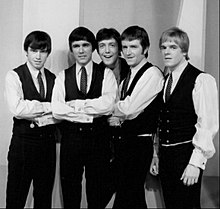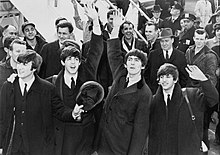Beat music
| Beat | |
|---|---|
| Stylistic origins |
|
Beat music, British beat, or Merseybeat is a British popular music genre that developed, particularly in and around Liverpool, in the late 1950s and early 1960s. The genre melded influences from British and American rock and roll, rhythm and blues, skiffle, traditional pop and music hall. It rose to mainstream popularity in the UK and Europe by 1963 before spreading to North America in 1964 with the British Invasion. The beat style had a significant impact on popular music and youth culture, from 1960s movements such as garage rock, folk rock and psychedelic music.
Origin
The exact origins of the terms 'beat music' and 'Merseybeat' are uncertain. The "beat" in each, however, derived from the driving
The 'Mersey' of 'Merseybeat' refers to the River Mersey. Liverpool lies on the eastern side of the river's estuary.
The name
Characteristics
The most distinctive characteristic of beat music was its strong beat, using the backbeat common to rock and roll and rhythm and blues, but often with a driving emphasis on all the beats of 4/4 bar.[7] The rhythm itself—described by Alan Clayson as "a changeless four-four offbeat on the snare drum"—was developed in the clubs in Hamburg, West Germany, where many English groups, including the Beatles, performed in the early 1960s and where it was known as the mach schau (make show) beat.[8] The 8/8 rhythm was flexible enough to be adopted for songs from a range of genres. In addition, according to music writer Dave Laing,[8]
"[T]he chord playing of the rhythm guitar was broken up into a series of separate strokes, often one to the bar, with the regular plodding of the bass guitar and crisp drumming behind it. This gave a very different effect from the monolithic character of rock, in that the beat was given not by the duplication of one instrument in the rhythm section by another, but by an interplay between all three. This flexibility also meant that beat music could cope with a greater range of time-signatures and song shapes than rock & roll had been able to".
Beat groups usually had simple
Emergence

In the late 1950s, a flourishing culture of groups began to emerge, often out of the declining skiffle scene, in major urban centres in the UK like Liverpool, Manchester, Birmingham and London. This was particularly true in Liverpool, where it has been estimated that there were around 350 different bands active, often playing ballrooms, concert halls and clubs.[3] Liverpool was perhaps uniquely placed within Britain to be the point of origin of a new form of music. Commentators have pointed to a combination of local solidarity, industrial decline, social deprivation, and the existence of a large population of Irish origin, the influence of which has been detected in Beat music.[11] It was also a major port with links to America, particularly through the Cunard Yanks,[12] which made for much greater access to American records and instruments like guitars, which could not easily be imported due to trade restrictions.[11] As a result, Beat bands were heavily influenced by American groups of the era, such as Buddy Holly and the Crickets (from which group the Beatles derived their name, combining it with a pun on the beat in their music),[13] and to a lesser extent by British rock and roll groups such as the Shadows.[14]
After the national success of the Beatles in Britain from 1962, a number of Liverpool performers were able to follow them into the charts, including
Outside of Liverpool many local scenes were less influenced by rock and roll and more by the rhythm and blues and later directly by the blues. These included bands from Birmingham who were often grouped with the beat movement, the most successful being the Spencer Davis Group and the Moody Blues. Similar blues influenced bands who broke out from local scenes to national prominence were the Animals from Newcastle[15] and Them from Belfast.[16] From London, the term Tottenham Sound was largely based around the Dave Clark Five, but other London-based British rhythm and blues and rock bands who benefited from the beat boom of this era included the Rolling Stones,[17] the Kinks and the Yardbirds.[18]
British Invasion

The Beatles' appearance on
Freakbeat
Freakbeat is a subgenre of
Decline
By 1967, beat music was beginning to sound out of date, particularly compared with the "harder edged" blues rock that was beginning to emerge.
Most of the groups that had not already disbanded by 1967, like the Beatles, moved into different forms of rock music and pop music, including psychedelic rock and eventually progressive rock.[28]
Influence
Beat was a major influence on the American garage rock[29] and folk rock movements,[30] and would be a source of inspiration for subsequent rock music subgenres, including Britpop in the 1990s.[31]
See also
Notes
- ^ ISBN 0-7456-3162-2, p. 98.
- ISBN 3-88199-145-X.
Während der fünfziger Jahre schrieb ich eine wöchentliche Spalte in der englischen Musikzeitschrift 'Melody Maker'. Um den englischen Imitationen der amerikanischen Rhythm-and-Blues, Rock-and-Roll und Skiffle Bands einen Namen zu geben, erfand ich das Wort 'beat music', das sich mittlerweile in vielen Sprachen eingebürgert hat.
- ^ a b "The Founders' Story 2 - Bill & Virginia Harry". Triumphpc.com. Retrieved 2 August 2019.
- ^ B. Eder and R. Unterberger, "The Merseybeats", AllMusic, retrieved 16 June 2009.
- ISBN 9781846311901. Retrieved 20 June 2013.
- ^ B. Eder, "Various artists: Brum Beat: the Story of the 60s Midland Sound", AllMusic, retrieved 5 February 2011.
- ^ P. Hurry, M. Phillips and M. Richards, Heinemann Advanced Music (Heinemann, 2001), p. 158.
- ^ ISBN 9780754668053. Retrieved 2 July 2013.
- ISBN 0-8264-6322-3, p. 78.
- ^ Nell Irvin Painter, Creating Black Americans: African-American History and Its Meanings, 1619 to the Present (Oxford: Oxford University Press, 2006), p. 261.
- ^ ISBN 0-85323-727-1, pp. 157–66.
- ^ Coslett, Paul. "Cunard Yanks". BBC Liverpool. Retrieved 31 December 2018.
- ^ Gilliland 1969, show 27, track 4.
- ISBN 0-19-514105-9, pp. 37–8.
- ^ a b c Gilliland 1969, show 29.
- ISBN 0-312-83469-1, p. 75.
- ^ a b Gilliland 1969, show 30.
- ISBN 0-19-510005-0, p. 60.
- ^ Gilliland 1969, show 28.
- ^ Gilliland 1969, show 48.
- ^ "British Invasion". Encyclopædia Britannica. Retrieved 23 January 2016.
- ^ Richie Unterberger (3 April 2007). "Joe Meek's Freakbeat: 30 Freakbeat, Mod and R&B Nuggets - Joe Meek | Songs, Reviews, Credits". AllMusic. Retrieved 29 November 2015.
- ^ Richie Unterberger (29 November 2011). "Looking Back: 80 Mod, Freakbeat & Swinging London Nuggets - Various Artists | Songs, Reviews, Credits". AllMusic. Retrieved 29 November 2015.
- ^ "Looking Back: 80 Mod, Freakbeat & Swinging London Nuggets - Various Artists | Songs, Reviews, Credits | AllMusic". AllMusic. Retrieved 5 September 2020.
- Factmag.
- ^ "Freakbeat Music Genre Overview". AllMusic. Retrieved 5 September 2020.
- ^ Erlewine, Stephen Thomas. "Various Artists: Nuggets, Vol. 2: Original Artyfacts from the British Empire & Beyond". AllMusic. Archived from the original on 5 July 2015. Retrieved 10 July 2015.
- ISBN 0-19-509888-9, p. 11.
- ^ V. Bogdanov, C. Woodstra and S. T. Erlewine, All music guide to rock: the definitive guide to rock, pop, and soul (Backbeat Books, 3rd end., 2002), pp. 1320-1.
- ^ R. Unterberger, "Merseybeat" Archived 23 April 2012 at the Wayback Machine, retrieved 5 February 2011.
- ISBN 0-7546-6805-3, pp. 103-122.
References
- Gilliland, John (1969). "The British Are Coming! The British Are Coming!: The U.S.A. is invaded by a wave of long-haired English rockers" (audio). Pop Chronicles. University of North Texas Libraries.
- Leigh, S., (2004) Twist and Shout!: Merseybeat, The Cavern, The Star-Club and The Beatles (Nirvana Books), ISBN 0-9506201-5-7(updated version of Let's Go Down to the Cavern)
- May, Chris; Phillips, Tim (1974). British Beat. Socion Books. London. ISBN 978-0-903-98501-7
